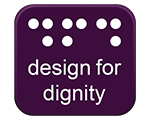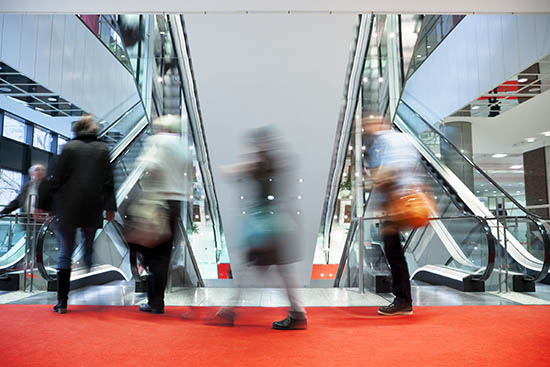Design For Dignity
Retail Guidelines




Yu et al (2015)*Yu, H., Tullio-Pow, S., Akhtar, A., March 2015, Retail design and the visually impaired: A needs assessment, Journal of Retailing and Consumer Services examined the issues and barriers that people with vision impairment experience when shopping, and how retailers can provide a combination of physical and services factors, to address the issues. The main findings on the physical environment were:
In surveys across different service industries AND has found that customers with disability tend to rate attitude, disability confidence and availability of employees very highly. When physical access or poor process threatens to make a bad experience, employee disability awareness can often rescue the situation until a resolution can be found.
Employee awareness was the most highly rated attribute within a store by survey respondents with 90% of people saying it is very important or critically important. Being aware of the needs of customers and treating people as individuals is a fundamental element of good service. Having basic strategies in place for communication, service and payment will assist in building a loyal customer base.
“Educate their staff about keeping aisles clear from obstacles, how to guide someone who is blind or has low vision, how different disabilities affect people's functional ability and encourage some basic kindness.”
Not every customer needs assistance in shopping, but there are times for all shoppers when assistance is needed. For someone experiencing disability, the assistance may be in navigating the store, finding items on shelves, having the differences between products described to them, reaching products that are placed on a higher shelf or display unit or assistance with paying for the goods or services.
“Provide assistance to someone with a disability to collect items off shelves. I use a carer to assist me but there are times I am by myself so having access to an employee to assist me would help a great deal.”
Yu et al (2015) found that the extent to which activities could be undertaken independently and without assistance from family members and store assistants was important. Common issues in a retail environment that were service related were over-servicing (patronising), reluctance to serve (lack of disability confidence), insensible payment procedures (unable to see the cost of items, payment terminal or not having change counted back properly) and lack of product knowledge.
No one likes to go shopping in crowded or awkward places. For people with a range of disabilities, well laid out spaces without clutter and obstacles is even more important as these can be physical barriers, trip hazards, or simply a confusing diversion as the person tries to purchase goods or services.
“Wider aisles please. I am blind and use a long cane, nothing obstructing the walkways either - they are a hazard.”
Being able to clearly read price and product information is necessary for all customers. Large font size, simple font types and good colour contrast can help people independently identify what they are after. How different zones of a store are coloured or marked out can assist people in quickly finding their way around.
“Maybe colour code the different sections/signs/labels of the supermarket e.g. food, electrical, pet food, freezer, greeting cards, hygiene because currently all the sections look the same and the signs in every aisle could be better positioned and easily identifiable.”
Balancing the need to maximise product display areas and shelving with the need to be able to reach products and maintain good access can sometimes be a challenge. Customers in the survey suggested how items are stocked and having customer service staff who are aware of people with disability can greatly assist.
“In my case I needed to shop with a carer but it would be nice in some cases to be able to use the store independently with the assistance of store people. That would be to get a limited amount of items from the shelves, bagged and paid for with assistance.”
While not an immediately obvious factor, the survey showed that employing people with disability was thought to improve the understanding of the rest of the team. This didn't seem to be motivated by ‘tokenistic’ behaviour, but having a co-worker with disability who is able to do the job would drive a better sense of inclusion and understanding.
“Employment of people with a disability, I believe, would help with education and awareness of people with a disability. Inclusion and equality would go a long way in improving the service.”
Clear overhead signage allows people to more easily navigate larger stores and find the most direct route or services that may be required, such as toilets.
The ABS*Adapted from Australian Bureau of Statistics, Survey of Disability, Ageing and Carers (2012) Table 23. Persons with disability aged 15 years and older, living in households, Disability status by mode of transport and reason for last journey tells us that 40 percent of all people with reported disability made their last journey somewhere to do shopping. Of that number 57 percent drove a car to get there, 29 percent were a passenger in a motor vehicle, 9 percent walked and 5 percent took public transport. For some people who can't drive or have limited mobility, home delivery becomes a very practical and useful service. For others, assistance in getting goods to a car can be just as helpful.
Being able to independently find your store is the starting point of the relationship. For larger stores, signage within the store is equally important in quickly locating the goods or services that you offer. Directional signage that has a simple font style, large print, good colour contrast, consistent use of pictograms and can be seen from a distance is best. Where you are providing directional signage to toilet facilities you should use the mandated range of standard signage including the International Symbol of Disability.
So what is tactile signage? Tactile signage is signage that includes either braille or raised lettering, shapes or figures to convey meaning to someone who can't see your signs. You will most commonly see them on lifts and signage for accessible toilets. Tactile signage can be used imaginatively to let people know where they are within your store.
Users of braille also benefit from braille signage and information in other ways. Emergency instructions in lifts in braille mean that someone can understand instruction in an emergency. Braille menus in a restaurant setting ensure that the person is able to independently know what is on special and to order for themselves. Wimpy Burgers*Wimpy Burger Promotional Video: https://www.youtube.com/watch?v=5YAchE0-o-o
Viewed September 2016 in South Africa launched braille menus with a unique social media campaign that gave people who used braille the ability to ‘see’ their food before they tasted it for the first time.
In the surveys, hearing augmentation described a range of solutions that can be provided by businesses to assist people who use hearing aids to hear the sales or service conversation better. The requirements for hearing augmentation in premises are listed later in this guide, but in retail stores they are particularly useful where:

In 2005 architect Hansel Bauman (of hbhm architects) and Gallaudet University established the DeafSpace Project*http://www.gallaudet.edu/campus-design/deafspace.html
Viewed September 2016. It was a project involving the university's design students to understand how the university campus could be designed to better include people who were deaf.
It was an exercise that recognised that people who use sign language often adjust their surroundings to enable better communication. Using sign language requires space between people to be able to see hand movements and the person's face. This has implications for design of pathways and ensuring spaces are uncluttered so that two people in conversation can focus on each other rather than obstacles (or blind corners at passage intersections). It also requires that the lighting is sufficient to see, but also that it is diffused to reduce glare, eliminate strongly back-lit situations and enable longer conversations without eye-strain. People who use hearing aids or cochlear implants can also be very sensitive to sound reverberating off hard surfaces.
The implications for retail design overlap with the needs of many other users: